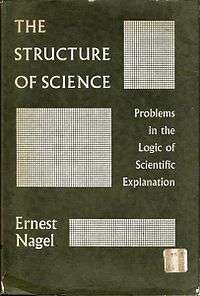The Structure of Science
 Cover of the first edition | |
| Author | Ernest Nagel |
|---|---|
| Country | United States |
| Language | English |
| Subject | Philosophy of science |
| Published | 1961 |
| Publisher | Harcourt, Brace & World |
| Media type | Print (Hardcover and Paperback) |
| Pages | 618 (second edition) |
| ISBN | 978-0915144716 |
The Structure of Science: Problems in the Logic of Scientific Explanation is a 1961 book about the philosophy of science by the philosopher Ernest Nagel.[1] The book is a well-known classic in its field, though Nagel's approach has been seen as outdated.
Summary
Nagel took an ahistorical, prescriptive approach to the philosophy of science.[1] He argued that most scientific hypotheses can be tested only indirectly. It is necessary to derive observable consequences from a hypothesis and then test them, thus providing second-hand proof for or against the hypothesis. Theory reduction has a deductive inference at its heart. Nagel maintained that morality, since it is about the way the world should be, is irrelevant to scientific inquiry, which is concerned with the way the world is. To entangle morality with science is to commit numerous fallacies.[2]
Nagel criticized Isaiah Berlin's paper "Historical Inevitability". He concluded The Structure of Science with the words, "However acute our awareness may be of the rich variety of human experience, and however great our concern over the dangers of using the fruits of science to science to obstruct the development of human individuality, it is not likely that our best interests would be served by stopping objective inquiry into the various conditions determining the existence of human traits and actions, and thus shutting the door to the progressive liberation from illusion that comes from the knowledge achieved by such inquiry."[3]
Scholarly reception
Seen as Nagel's definitive work,[1] The Structure of Science is a well-known classic in its field.[4] The philosopher Adolf Grünbaum, writing in Philosophical Problems of Space and Time (1963), criticized Nagel for misinterpreting the philosopher of science Henri Poincaré.[5] The historian Peter Gay praised The Structure of Science as an important book and a clear exposition of positivism, crediting Nagel with refuting opposing points of view.[6] Gay has also written that The Structure of Science is a book on which "many of us grew up", and that it "remains valuable". Gay noted that while Nagel was "no Freudian", the closing sentence of Nagel's book paraphrases the famous last paragraph of Sigmund Freud's The Future of an Illusion (1927).[7]
The philosopher Michael Ruse, writing in Homosexuality: A Philosophical Inquiry (1988), concluded that Thomas S. Kuhn's The Structure of Scientific Revolutions (1962) discredited the ahistorical, prescriptive approach to the philosophy of science Nagel took in The Structure of Science.[1]
References
Footnotes
Bibliography
- Books
- Gay, Peter (1990). Reading Freud: Explorations & Entertainments. New Haven & London: Yale University Press. ISBN 0-300-05127-1.
- Gay, Peter (1988). Style in History: Gibbon, Ranke, Macaulay, Burckhardt. New York: W. W. Norton & Company. ISBN 0-393-30558-9.
- Grünbaum, Adolf (1974). Philosophical Problems of Space and Time. Boston: D. Reidel Publishing Company. ISBN 90 277 0358 2.
- Levi, Isaac (1999). Audi, Robert, ed. The Cambridge Dictionary of Philosophy. Cambridge: Cambridge University Press. ISBN 0-521-63722-8.
- Ruse, Michael (1988). Homosexuality: A Philosophical Inquiry. New York: Basil Blackwell. ISBN 0 631 15275 X.
- Ruse, Michael (2005). Honderich, Ted, ed. The Oxford Companion to Philosophy. Oxford: Oxford University Press. ISBN 0-19-926479-1.